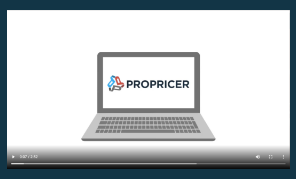It’s been more than 40 years since we’ve seen soaring inflation rates like the present day. And as long as there’s a demand for limited services and supplies, inflation will continue to grow. If the government institutes price controls, they won’t aid existing product shortages and may in fact magnify them. 4
Now more than ever, government contracting requires crystal-ball predictions to address every dimension of cost and pricing. Turning idealism into reality is especially tricky for contract pricing during inflation.
If you significantly overestimate inflation, your offer will likely be higher than your competitors’, resulting in failure to win an award. But if you underestimate inflation, you may end up underwater – performing the contract at a significant loss. 3
According to the U.S. Bureau of Labor Statistics, the consumer price index (CPI)—one measure of inflation—has risen 8.3% over the last 12 months, and it’s still growing. Resultant costs impact those performing cost-reimbursement contracts. And to a much greater extent, contractors working on fixed-price contracts. 2, 3
Cost-reimbursement contracts
In a cost-reimbursement contract, your partner agency will pay actual and reasonable costs you’ve incurred. However, any fee you suggest to compensate your team for the risks of delivering on that commitment—in other words, a margin increase— will be very low, if anything at all.
For cost-reimbursement contracts that include Limitation of Cost or Limitation of Funding clauses, you’re obligated to notify your agency Contracting Officer (CO) as you approach the limits of the contract’s funding. The upside, if you can call it that, is if you as a contractor don’t have to continue performance beyond what you can accomplish under that funding ceiling. The onus, then, is on your agency’s CO to seek more funding in order to continue your performance. 4
Fixed-price contracts
How and when can COs offer inflation-related adjustments to contractors in fixed-price contracts? The short answer is that, unfortunately, the concessions can’t be solely related to inflation.
Though many would argue inflation-rated work cycles and costs should be shared by the contractor and the government, the reality of this perspective hasn’t fully taken hold. Concessions are also generally dependent upon the CO making an additional request in contract delivery that’s new to the contractor and not included in the original RFP.
In this respect, agencies seem quick to adopt an idealistic perspective—at least for the government— under the Changes clause in the Federal Acquisition Regulation (FAR) section that speaks to fixed-price contracts.
But that doesn’t completely rule out more realistic pricing for contractors and the potential for profit.
Fixed-price contracts that already contain an adjustments clause have the best hope for contractor profitability, and many COs are now adding that clause into new acquisition solicitations. 1
Let’s take a look at how you can approach each of the inflationary scenarios currently in play for fixed-price contracts at the Department of Defense (DoD) and other agencies:
1. Figure out how to negotiate adjustments for existing fixed-price contracts
Currently COs can make a good-faith adjustment to a fixed-price contract in cases covered by the standard Changes clause at FAR 52.243-1. The DoD and other agencies are in fact trying to find other ways to help contractors address unanticipated inflation, which is the state we live and work in now.
But unfortunately, the government still takes a rather limited view of the standard Changes clause. The clause allows for adjustments only when there is a CO-directed change within the scope of the contract, which means you can’t receive pricing adjustment permission unless your CO partner has shifted something within the proposal process that warrants more funds. In other words, the government’s recent guidance discourages COs from granting equitable adjustments based purely on inflation.
That said, the guidance leaves open the possibility of inflation-related claims when a contracting officer has directed changes within the scope of the clause. This could include situations where a contracting officer administers a different method of performance because of changed economic conditions (e.g., directions to use an alternative services method from the one specified in the original proposal).
Yes, if you’re experiencing increased costs, you should think broadly about potential changes caused by the contracting officer, which could open the door to adjustments. 1
Your proactive next steps: Study the contents of your current fixed-price proposal versions carefully, and look for language that could indicate that a CO requested a change or changes. Bring these passages up to your agency CO, and ask that an adjustment be made based on 1.) Increased contractor costs as a result of change orders in the contract, combined with 2.) More equitable inflationary measures.
2. Look for contracts that already include economic adjustment clauses
Fortunately, agencies developing RFPs now are willing to include economic adjustment clauses, providing they don’t develop pricing expectations based on worst case projections of market conditions. (The government expects COs to watch their agencies’ backs, first and foremost.)
Also, COs have to be mindful that inflation’s impacts vary widely, depending upon the nature of certain costs and where they fall within their appropriate price indexes.
Sadly, any clause placed in a contract can’t apply to the profit portion of the contract. So your expected cost adjustments should map to just that—your costs. 4
Your proactive next steps: Seek out contract RFPs that already have an economic adjustment clause in place. Some do, especially those posted in the last few months. A little research can save you a world of headache and many lost dollars.
3. Request concessions for new, fixed-price solicitations and contracts
Any fixed-price RFP currently in development can include Economic Price Adjustment (EPA) clauses, as specified by the FAR and Defense Federal Acquisition Regulation Supplement (DFARS).
Realistic COs can and do insert these clauses into draft and finished RFPs. In the former situation, if you’re not seeing the language you need upon review, ask your agency partner CO to include it. (COs can reference these document sections for appropriate clauses: FAR 52.216-4; DFARS 252.216-7000.)
Clauses allow pricing to adjust both ways: they enable upward and downward revision of contract pricing if that pricing meets contingencies. Adjustments are based on established prices, as well as actual costs or index costs of labor and materials.
There are a few prerequisites in place on the government’s end:
- Clauses have to benefit both the government and contractor in some way
- The contract length is a primary consideration; ideally, clauses are included in longer contracts
- The total contract price has to exceed the simplified acquisition threshold, which is currently $750K
- COs should exclude costs that don’t vary with inflation. 2
Your proactive next steps: Whenever you can, submit pre-RFP questions to your CO and otherwise encourage the inclusion of EPA clauses in new solicitations, especially in draft RFPs you’re asked to edit. Note: The term “Economic Price Adjustment” doesn’t necessarily have to appear in a contract, as any clause that addresses pricing changes due to economic conditions is effectively an EPA clause. But again, when in doubt, ask. 2, 3
Predict and adjust your proposal rates in a few clicks with ProPricer
Many contractors thrive on ProPricer’s ability to adjust data and rate tables on the fly, following cost and pricing reviews. Simply adjust applicable cost and pricing data once; all related and linked tables are adjusted automatically.
Take ProPricer Contractor Edition for a free, 30-day test drive. Get closer to your ideal profit potential in every contract by using the same pricing adjustment platform that most DoD agencies use. Experience speed and efficiency in contract negotiations that can help make a win/win proposal situation a reality.
Sources
- Covington Blog: DoD Releases Guidance on Inflation and Economic Adjustments for Fixed-Price Contracts
- Wiley Law Alert: Defense Economic Price Adjustments Amidst Growing Concerns Over Inflation
- Wardberry.com Article: Managing Inflation in Government Contracts
- JDSupra.com Article: Growing Issue of Inflation - Supply Chain Leads to DoD Clarification on Potential for Relief





